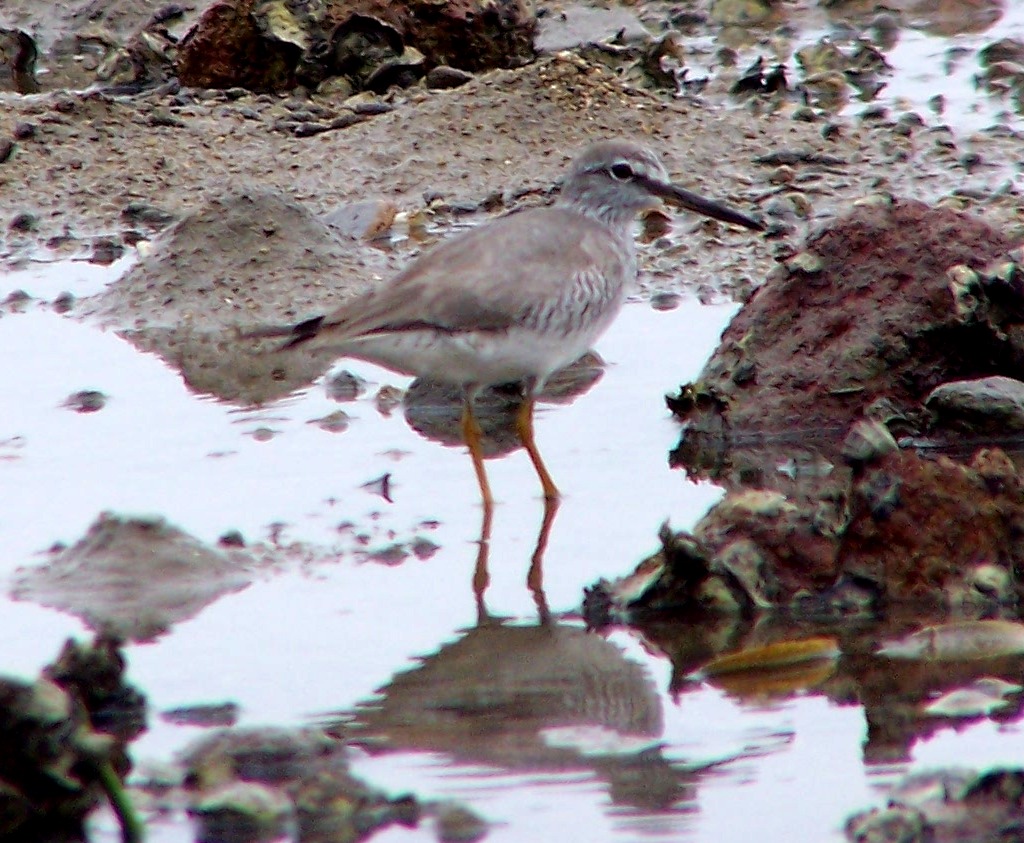- Grey-tailed Tattler
Taxobox
name = Gray-tailed Tattler

status = LC
status_system = IUCN3.1
regnum =Animal ia
phylum = Chordata
classis = Aves
ordo =Charadriiformes
familia =Scolopacidae
genus = "Tringa "
species = "T. brevipes"
binomial = "Tringa brevipes"
binomial_authority = (Vieillot, 1816)
synonyms ="Heteroscelus brevipes"The Grey-tailed Tattler, "Tringa brevipes" (formerly "Heteroscelus brevipes": Pereira & Baker, 2005; Banks "et al.", 2006), is a small
shorebird .Description
The Grey-tailed Tattler is closely related to its
North America n counterpart, theWandering Tattler ("T. incana") and is difficult to distinguish from that species. Both tattlers are unique among the species of "Tringa" for having unpatterned, greyish wings and back, and a scaly breast pattern extending more or less onto the belly in breeding plumage, in which both also have a rather prominentsupercilium .These birds resemble
Common Redshank s in shape and size. The upper parts, underwings, face and neck are grey, and the belly is white. They have short yellowish legs and a bill with a pale base and dark tip. There is a weak supercilium.They are very similar to their American counterpart, and differentiation depends on details like the length of the nasal groove and scaling on the tarsus. The best distinction is the call; Gray-tailed has a disyllabic whistle, and Wandering a rippling trill.
Behaviour
Its breeding habitat is stony riverbeds in northeast
Siberia . It nests on the ground, but these birds will perch in trees. They also sometimes use old nests of otherbird s.Grey-tailed Tattlers are strongly migratory and winter on muddy and sandy coasts from southeast
Asia toAustralia . They are very rare vagrants to western North America and westernEurope . These are not particularly gregarious birds and are seldom seen in large flocks except at roosts.These birds forage on the ground or water, picking up food by sight. They eat insects, crustaceans and other
invertebrate s.Conservation Status
Australia
Grey-tailed Tattlers are not listed as threatened on the Australian
Environment Protection and Biodiversity Conservation Act 1999 .tate of Victoria, Australia
* The Grey-tailed Tattler is listed as threatened on the Victorian
Flora and Fauna Guarantee Act (1988) . [ [http://www.dse.vic.gov.au/DSE/nrenpa.nsf/LinkView/EADA0F1874AF9CF24A2567C1001020A388BBA5581CF9D859CA256BB300271BDB Department of Sustainability and Environment, Victoria] ] Under this Act, an "Action Statement" for the recovery and future management of this species has not been prepared. [ [http://www.dse.vic.gov.au/DSE/nrenpa.nsf/LinkView/617768308BCB666E4A25684E00192281E7A24BB36FF60A144A256DEA00244294 Department of Sustainability and Environment, Victoria] ]* On the 2007 advisory list of threatened vertebrate fauna in Victoria, the Grey-tailed Tattler is listed as
critically endangered .cite book | author = Victorian Department of Sustainability and Environment | title = Advisory List of Threatened VertebrateFauna in Victoria - 2007 | publisher = Department of Sustainability and Environment | date = 2007 | location = East Melbourne, Victoria | pages = 15 | url = | id = ISBN 978-1-74208-039-0 ]References
* Banks, Richard C.; Cicero, Carla; Dunn, Jon L.; Kratter, Andrew W.; Rasmussen, Pamela C.; Remsen, J. V. Jr.; Rising, James D. & Stotz, Douglas F. (2006): Forty-seventh Supplement to the American Ornithologists' Union Check-list of North American Birds. "Auk" 123(3): 926–936. DOI: 10.1642/0004-8038(2006)123 [926:FSTTAO] 2.0.CO;2 [http://www.aou.org/checklist/Suppl47.pdf PDF fulltext]
* Database entry includes justification for why this species is of least concern
*"Shorebirds" by Hayman, Marchant and Prater ISBN 0-7099-2034-2* Hayman, Peter; Marchant, John & Prater, Tony (1986): "Shorebirds: an identification guide to the waders of the world". Houghton Mifflin, Boston. ISBN 0-395-60237-8
* Pereira, Sérgio Luiz & Baker, Alan J. (2005): Multiple Gene Evidence for Parallel Evolution and Retention of Ancestral Morphological States in the Shanks (Charadriiformes: Scolopacidae). "Condor" 107(3): 514–526. DOI: 10.1650/0010-5422(2005)107 [0514:MGEFPE] 2.0.CO;2 [http://www.bioone.org/perlserv/?request=get-abstract&issn=0010-5422&volume=107&issue=03&page=0514 HTML abstract]
Wikimedia Foundation. 2010.
